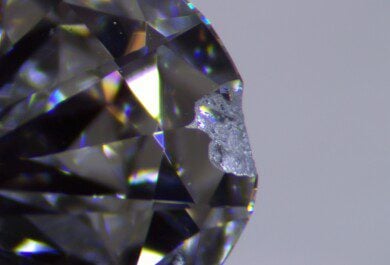“Levels of Confidence”
A pre-purchase, screening tool for the consumer. An explanation tool for the appraiser.
Intended to gauge the credibility of represented color, clarity and cut grades compared to GIA or AGSL grading.
Highest Confidence: SCORE = 1
The grade will exactly match GIA/AGS 65% to 70% of the time. This is about the level at which these lab’s own graders match each other’s grades while working on diamonds. This grade ONLY applies to loose diamonds. Only very highly experienced, properly trained and equipped graders can claim this level of confidence. Very few gem laboratories or gemologists actually have this degree of competence.
High Confidence: SCORE = 0.9 / 0.8 for loose diamonds SCORE = 0.8 / 0.7 for set diamonds
This is the best level of confidence normally available appraisers and gemologists bring to grading loose diamonds. The grade will match GIA/AGS grading close to 50% of the time and rarely vary more than a single grade from GIA/AGS grading.
This grade is the best possible level of confidence in grading set diamonds. The grade should approximate, within 1 to 2 grades, of the GIA/AGS grade that would be given if the diamonds were unset for re-grading. Since grades are very closely related at the best end, the range of “error” is potentially greater at the highest grades.
Skilled and experienced graders of mounted diamonds can give High Confidence mounted diamond grades. Graders who generally only grade loose diamonds, and others with limited experience grading mounted diamonds, will not have this high a level of confidence.
This grade is also the highest level of confidence in grading loose diamonds of unusual color hue, greater than N/O color, strongly UV fluorescent stones, glass filled diamonds, and surface coated stones. Fancy shaped diamonds with strong color zoning in the face-up position also cannot be graded with a higher level of confidence.
Standard Confidence: SCORE = 0.7 for loose diamonds SCORE = 0.6 for set diamonds
Less experienced appraisers and gemologists in training often have less pinpoint grading accuracy as they develop their skills. Labs with less than stellar reputations also often provide no better than this level of confidence. Due to lack of experience, lower lab standards or careless practices a grader may hit an exact IA/AGS grade from time to time, but will commonly be 1 to 2 grades off, depending on their expertise, equipment, knowledge, intent, attention to detail and how often they practice diamond grading techniques. Not everyone grades diamonds five or six days every week. Standard Confidence is the level of confidence at which many appraisers, gemologists, dealers and jewelers grade set diamonds. Getting the color grade on set diamonds to match loose diamond color grades of GIA/AGS to within a tolerance of 2 to 3 grades is about all that can be done with dependable reliability. Clarity grading of most mounted diamonds to a reasonable tolerance of 1 to 2 grades is generally possible. The most difficult end of clarity grading, as in color grading, is in the upper range of quality and some might say also at the SI2-I1 borderline.
Low Confidence: SCORE = 0.6 or lower for loose diamonds SCORE = 0.5 for set diamonds
Grading of diamonds without master stones. Grading in poor, unfamiliar or unusual lighting. Grading based on photographs. Grading by inexperienced consumers. Grades supplied by labs that don’t put contact information on their reports. Labs no one ever heard of. Diamonds graded and sealed in plastic which have their warranty voided if the plastic seal is broken to examine the diamond. Grading done by the seller. Grading of diamonds which are highly obstructed by mounting design elements such as wide prongs and/or backing.
Chart for Levels of Confidence in Color, Clarity and Cut grading.
|
A score of 1 pertains to GIA and AGS Labs
Deductions down to a score of 0 are possible.
This is a screening tool.
|
Unset Diamonds
Near colorless
D to M color
|
Unset Diamonds
Tinted “N” to yellow / brown fancy color or lighter tint of unusual fancy colors
|
Mounted Diamonds
Near colorless D to M color
Set in open back white metal
|
Mounted Diamonds,
Tinted to fancy color or near colorless
In closed back white metal setting or open back yellow metal setting
|
Mounted Diamonds,
Tinted to fancy color in closed back yellow or other colored metal, non-white setting
|
|
Daylight range,
Proper color walls constant lab environment
|
1
highest confidence
|
-.1
high confidence
|
-.2
high confidence
|
-.3
standard confidence
|
-.4
|
|
Daylight range,
Unfamiliar or unusual environment
|
-.1
high confidence
|
-.2
high confidence
|
-.3
standard confidence
|
-.4
|
-.5
|
|
Non-Daylight Lighting
Familiar environment
|
-.2
high confidence
|
-.3
standard confidence
|
-.4
|
-.5
|
-.6
|
|
Non-Daylight Lighting
Unusual environment
|
-.3
standard confidence
|
-.4
|
-.5
|
-.6
|
-.7
|
|
Insufficient lighting,
Tired eyes End of day grading
|
-.4
|
-.5
|
-.6
|
-.7
|
-.8
|
|
Dirty stones, and/or obstruction of view due to mounting
|
-.5
|
-.6
|
-.7
|
-.8
|
-.9
|
Further adjustments to the Level of Confidence must be taken for the potential of bias in grading. (subtract an additional 0.1 from above matrix)
1. A seller’s grade is viewed as less reliable than an independently arrived at grade. This may not be true, but there is an implied bias. -.1
2. A grade supplied by a major lab which has questionable credibility. The major labs suffering from, or deserving of, this reputation are easy enough to become aware of. -.1
3. A grade supplied by an unknown independent lab or unrecognized grader. How much credibility should a consumer give to such an opinion? -.1
by David S. Atlas, GG(GIA) Sr Mbr(NAJA) ASG(AGA)
datlas.com

Discuss on Forum
“A screening tool for all diamond grading”












